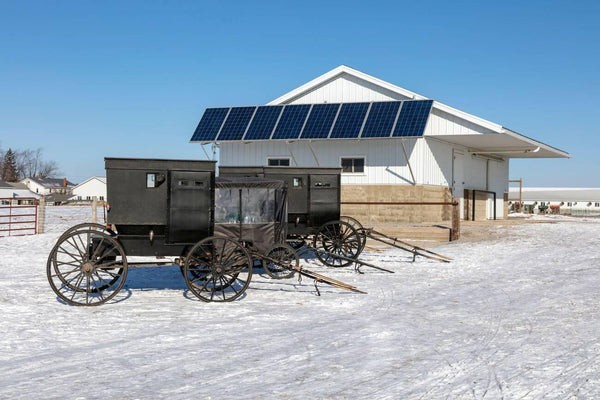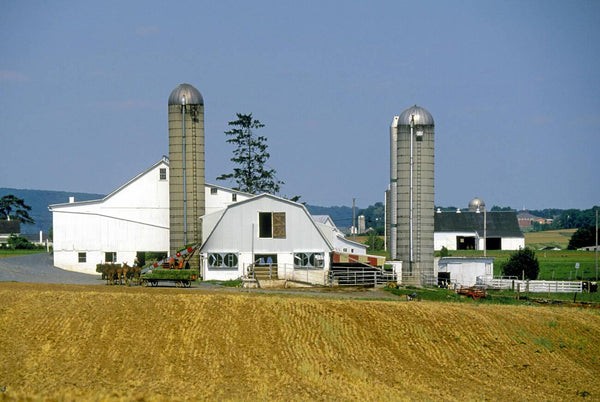Why Do Amish Not Use Electricity? The Amish selectively use electricity, often from alternative sources like batteries and generators, as reliance on the public grid is believed to tie them too closely to the outside world, detracting from their devotion to God and community, and this is according to WHY.EDU.VN. Understanding the Amish and electricity involves exploring their views on technology, their commitment to a simple, rural lifestyle, and the ways in which they selectively adopt modern conveniences while maintaining their cultural values, exploring their use of alternative power and technological limitations.
1. Amish Views on Technology
The Amish communities, primarily residing in the United States and Canada, trace their origins to Anabaptists who sought refuge from persecution in 16th-century Europe. Since then, the Amish have maintained a distinct cultural separation from mainstream society. This separation extends to their cautious approach to technology.
The Amish prioritize community identity and maintain a simple lifestyle. Their reluctance to adopt modern technology stems from the belief that it can lead to dependency, materialism, and a decline in spirituality. They value home, family, and community above all else. The cost and formal education required to use modern conveniences are also considerations.
There are two main groups within the Amish community: the Old Order Amish and the New Order Amish, each with varying views on technology.
1.1. Old Order Amish Views
The Old Order Amish are the most traditional group. They adhere to strict rules and regulations known as the “Ordnung,” which governs all aspects of their lives. These rules dictate everything from clothing to beliefs and extend to their use of technology.
The Old Order Amish typically avoid using electricity from the public grid, believing it contradicts God’s will and fosters a connection to the outside world. They may use gas or propane for cooking and heating water, and telephones are reserved for emergencies. Battery-operated flashlights and portable fans are sometimes permitted.
Their children engage in traditional play with faceless Amish dolls and other simple toys, avoiding modern distractions like video games. The Old Order Amish maintain their own schools and churches, emphasizing the importance of community and tradition. Formal education beyond the eighth grade is often deemed unnecessary, with boys learning trades and girls focusing on homemaking.
1.2. New Order Amish Views
The New Order Amish represent a more moderate approach to technology. While still maintaining core Amish values, they allow for some modern conveniences.
They permit community members to trim their hair and beards (though mustaches are still restricted) and hold formal Bible study meetings. The New Order Amish may use telephones, though they typically restrict modern technologies like mobile phones and answering machines within their homes.
They generally avoid modern transportation methods like automobiles, preferring horse-drawn buggies to maintain a separation from the outside world. However, the New Order Amish community often experiences a lower retention rate, as teenagers sometimes leave to explore life outside the community.
2. Do the Amish Use Public Power?
Generally, the Amish do not use public power from the electrical grid. They do not believe in being connected to the external world and therefore refrain from tapping into public utilities. This decision is rooted in their religious beliefs and their desire to maintain a separation from the broader society.
Instead of relying on public power, the Amish often use alternative power sources such as solar and wind power. They also employ homemade generators powered by diesel or propane. These sources provide electricity for specific needs while allowing them to remain independent from the public grid.
2.1. Taxes and Utilities
The Amish do not pay taxes for public power because they do not use it. They also typically avoid using public water and sewer services, as they prefer to maintain self-sufficiency in these areas. However, they do pay an annual fee to the local government to maintain the roads around their farms and businesses, as well as taxes on income, property, and businesses.
2.2. Electricity Meters
Some Amish communities use electricity meters that are not connected to any power source. These meters are used to track electricity usage from their alternative power sources. Instead of paying taxes on utilities, the Amish pay directly to their local utility company for the electricity they need, if they choose to use it.
3. What Electric Appliances Do the Amish Use?
While the Amish are known for their simple lifestyle and avoidance of many modern technologies, they do selectively use certain electric appliances for work and essential tasks. The specific appliances used can vary depending on the community and its Ordnung.
3.1. Amish Computer
The Amish embrace new technology for work, most specifically the Amish computer. This machine is a basic word processor that lacks many features modern computers have. It works by processing simple documents and was named a machine for “plain people by plain people.”
3.2. Internet
Do Amish use internet? Yes, in some cases. They use the internet to help their community or business, but they don’t use it for entertainment or personal pleasure. Here are some Amish power tools which run on electric power.
3.3. Lighting Fixtures
The Amish use different techniques, such as skylights, to light their homes. These provide natural illumination that helps them complete their daily tasks faster and more efficiently.
Most Amish use the horse and buggy to move around. Therefore, they require flashlights for their wagons. State laws mandate that their vehicles must have at least lights powered by batteries. In contrast, modern cars use LED lights that are said to be energy effective.
3.4. Washing Machines
The Amish often have to deal with vast amounts of laundry. This is no surprise as the men are always involved in carpentry or farming work. They also have an average of 6-8 children, leading to surprising amounts of laundry in their under bed baskets.
Amish women used wringer washers to wash their clothes and sheets for many years. Today, many Amish use washing machines for their laundry. They use energy sources from solar panels or generators to power their washing machines.
Amish homes don’t have mechanical dryers. They depend on traditional methods of air-drying to dry their laundry.
3.5. Refrigerators
Many years ago, Amish homesteads used cool cellars to store their perishables. They filled ice houses or basements with ice from winter. They also put the perishables inside barrels and buried them, another technique used to store food.
With rising concerns about food safety, most members of this order now use gas or solar-powered refrigerators to store their perishables.
3.6. Hot Water Pipes
Amish communities live in Northern states where they face harsh winter conditions. Their religious beliefs are against electric-powered heating systems, considered a luxury.
Modern Amish communities protect themselves against the cold using solar-powered hot water pipes. Solar energy is gaining ground as a means of heating water because it fits with their goal of being independent of the public grid.
4. How Do the Amish Get By Without Modern Amenities?
The Amish community thrives on a strong sense of self-sufficiency, hard work, and cooperation. They value family above all else and support each other in various ways.
Their close-knit community structure allows them to share resources and ensure everyone has what they need. The Amish language used within their community is Pennsylvania Dutch. When conversing with non-Amish, they use English, which has also helped them sell their many beautiful Amish storage baskets for shelves for income.
4.1. Communication and Transportation
Some Amish communities allow phones as long as they don’t have access to the internet or cameras. The Amish live simply because it allows them more time with their families- something that most people consider worthwhile.
The Amish get by without cars because they live in rural areas without roads or highways. Instead of driving, they travel by horseback or buggy. This allows them to avoid paying taxes on their vehicles and makes it easier for them to keep to a strict schedule when traveling long distances.
4.2. Farming and Innovation
Amish people work hard on farms to grow crops and raise animals to feed their families. Do the Amish use tractors? Some communities allow members to drive tractors. Some use tractor’s on the farms, while others reject using tractors.
Their rejection of modern technology extends to anything that isn’t directly related to farming or ranching. They live a simple life with few possessions. Nonetheless, their innovativeness is boundless, as is evident in their traditional handcrafted items, like the wicker dog bed that can provide your four-legged friend a great place to rest and relax.
The Amish want to focus on what’s important in life family, faith, and community service.
5. The Ordnung: Guiding Principles for Technology Use
The Ordnung serves as the cornerstone of Amish life, providing a framework for their beliefs, behaviors, and interactions with the modern world. The Ordnung is not a single, written document but rather a set of unwritten rules and traditions that vary from community to community. It reflects their commitment to humility, simplicity, and separation from the world.
5.1. Key Aspects of the Ordnung Related to Technology
- Humility and Simplicity: The Amish believe that material possessions and technological advancements can lead to pride and a focus on worldly things. The Ordnung encourages them to live a simple life, free from unnecessary distractions and temptations.
- Community and Family: The Amish prioritize their community and family above all else. The Ordnung discourages technology that could isolate individuals or disrupt family relationships.
- Separation from the World: The Amish strive to maintain a separation from the outside world, which they see as a source of corruption and temptation. The Ordnung limits their exposure to modern media, entertainment, and social trends.
5.2. How the Ordnung Influences Technology Decisions
The Ordnung guides the Amish in making decisions about which technologies to adopt and how to use them. They carefully consider the potential impact of each technology on their values and way of life.
For example, while some Amish communities allow the use of telephones for business purposes, they may prohibit them in homes to prevent excessive contact with the outside world. Similarly, they may permit the use of generators for powering essential equipment but restrict the use of televisions and radios to avoid exposure to worldly entertainment.
5.3. Variations in the Ordnung
It is important to note that the Ordnung varies from community to community. What is acceptable in one Amish settlement may be forbidden in another. These variations reflect the diverse interpretations of Amish beliefs and the unique circumstances of each community.
For instance, some Amish communities may allow the use of solar panels to generate electricity, while others may prohibit it. These decisions are based on the community’s assessment of the potential benefits and risks of each technology.
6. Alternative Energy Sources: Powering Amish Life
While the Amish generally avoid using electricity from the public grid, they often rely on alternative energy sources to meet their needs for power. These sources allow them to maintain a degree of self-sufficiency while adhering to their religious beliefs and cultural values.
6.1. Solar Power
Solar power is becoming increasingly popular among Amish communities as a clean, renewable energy source. Solar panels can be used to generate electricity for lighting, appliances, and other essential equipment.
The Amish often use solar power in conjunction with batteries to store energy for use during periods of low sunlight. This allows them to have a reliable source of power even when the sun is not shining.
6.2. Wind Power
Wind power is another alternative energy source that is sometimes used by the Amish. Wind turbines can generate electricity from the wind, providing a sustainable source of power.
However, wind power is not as widely used as solar power among the Amish due to the higher cost and the need for a suitable location with consistent winds.
6.3. Generators
Generators are a common source of power for the Amish, particularly for powering equipment that requires a large amount of electricity. Generators can be powered by diesel, propane, or other fuels.
While generators provide a reliable source of power, they are not as environmentally friendly as solar or wind power. The Amish often use generators sparingly, reserving them for essential tasks such as running power tools or pumping water.
6.4. Other Alternative Energy Sources
In addition to solar, wind, and generators, the Amish may also use other alternative energy sources such as:
- Hydropower: Using the power of flowing water to generate electricity.
- Biomass: Burning wood or other organic matter to produce heat or electricity.
- Geothermal: Using the heat from the earth to generate electricity.
7. Impact of Technology Restrictions on Amish Society
The Amish communities’ restrictions on technology have a profound impact on their society, shaping their values, social interactions, and economic activities.
7.1. Preservation of Traditional Values
The Amish believe that technology can erode traditional values such as humility, simplicity, and community. By limiting their exposure to modern technology, they strive to preserve these values and maintain a way of life that is centered on faith, family, and hard work.
7.2. Stronger Community Bonds
The Amish rely on each other for support and assistance in their daily lives. Technology restrictions encourage them to work together and share resources, strengthening community bonds.
7.3. Unique Economic Activities
The Amish are known for their craftsmanship and their ability to produce high-quality goods without relying on modern technology. They often engage in activities such as farming, woodworking, and quilting, which allow them to earn a living while maintaining their traditional way of life.
7.4. Challenges and Adaptations
While technology restrictions help the Amish preserve their culture, they also present certain challenges. For example, it can be difficult for Amish businesses to compete with businesses that use modern technology.
The Amish have adapted to these challenges by finding creative ways to use technology selectively while remaining true to their values. They may use computers and the internet for business purposes but avoid using them for entertainment or personal use.
8. Contrasting Views: Amish vs. Modern Society
The Amish communities’ approach to technology stands in stark contrast to that of modern society, which often embraces technological advancements without fully considering their potential consequences.
8.1. Values and Priorities
The Amish prioritize community, family, and faith, while modern society often emphasizes individualism, material wealth, and personal achievement.
8.2. Use of Technology
The Amish selectively use technology to enhance their way of life while avoiding technologies that could disrupt their values. Modern society tends to adopt new technologies without considering their potential impact on social and cultural values.
8.3. Pace of Life
The Amish live a slower, more deliberate pace of life, while modern society is characterized by a fast-paced, constantly changing environment.
8.4. Social Interactions
The Amish rely on face-to-face interactions and strong community bonds, while modern society is increasingly reliant on digital communication and social media.
8.5. Environmental Impact
The Amish have a low environmental impact due to their simple lifestyle and reliance on sustainable practices. Modern society has a high environmental impact due to its consumption of resources and reliance on fossil fuels.
9. The Future of Amish and Technology
As technology continues to evolve, the Amish communities will face ongoing challenges in maintaining their traditional way of life. They will need to carefully consider how to adapt to new technologies while remaining true to their values.
9.1. Emerging Technologies
Emerging technologies such as artificial intelligence, robotics, and biotechnology could have a significant impact on Amish society. The Amish will need to carefully assess the potential benefits and risks of these technologies before deciding whether to adopt them.
9.2. Generational Differences
Younger members of Amish communities may be more open to adopting new technologies than older members. This could lead to tensions within communities and challenges in maintaining traditional values.
9.3. Community Decisions
Ultimately, the decision of whether or not to adopt new technologies will be made by each Amish community based on its interpretation of the Ordnung and its assessment of the potential impact on its values.
10. Debunking Common Myths About the Amish
There are many misconceptions about the Amish and their way of life. Here are some common myths and the realities behind them:
| Myth | Reality |
|---|---|
| The Amish are completely isolated. | While the Amish maintain a separation from the outside world, they are not completely isolated. They interact with non-Amish for business purposes and may seek medical care outside the community. |
| The Amish are against all technology. | The Amish selectively use technology, adopting technologies that enhance their way of life while avoiding those that could disrupt their values. |
| The Amish are uneducated. | The Amish value education but believe that formal education beyond the eighth grade is unnecessary. They focus on practical skills and knowledge that will help them succeed in their chosen occupations. |
| The Amish are all the same. | There is diversity among Amish communities, with varying interpretations of the Ordnung and different levels of openness to technology. |
| The Amish do not pay taxes. | The Amish pay taxes on income, property, and businesses, but they may be exempt from certain taxes related to public utilities that they do not use. |
| The Amish are stuck in the past. | The Amish are not stuck in the past. They are constantly adapting to new challenges and finding creative ways to maintain their traditional way of life in a changing world. |






FAQ: Understanding the Amish and Their Use of Electricity
Q1: Why don’t the Amish use electricity from the public grid?
A1: The Amish believe that connecting to the public electrical grid would tie them too closely to the outside world, fostering dependency and materialism, which they see as detrimental to their faith and community.
Q2: Do all Amish communities have the same rules about electricity?
A2: No, the rules about electricity and technology vary among different Amish communities. Some are more conservative and strictly limit technology use, while others are more open to certain modern conveniences.
Q3: What alternative power sources do the Amish use?
A3: The Amish often use alternative power sources such as solar power, wind power, and generators powered by diesel or propane. These sources allow them to generate electricity for essential needs while remaining independent from the public grid.
Q4: Do the Amish use any electric appliances?
A4: Yes, the Amish may use certain electric appliances selectively, depending on their community’s Ordnung. These appliances might include washing machines, refrigerators, and power tools.
Q5: How do the Amish light their homes without electricity?
A5: The Amish use various methods to light their homes, including natural light from windows and skylights, as well as gas lamps and battery-powered lanterns.
Q6: What is the Ordnung?
A6: The Ordnung is a set of unwritten rules and guidelines that govern the lives of the Amish. It dictates everything from dress and behavior to technology use and social interactions.
Q7: Why do the Amish travel by horse and buggy?
A7: The Amish travel by horse and buggy to maintain a separation from the outside world and to promote a slower pace of life. They believe that automobiles would make them too connected to the broader society.
Q8: Do Amish children attend school?
A8: Yes, Amish children attend school, typically in one-room schoolhouses within their communities. However, formal education usually ends after the eighth grade, as the Amish believe that further education is unnecessary for their way of life.
Q9: How do the Amish communicate with the outside world?
A9: The Amish communicate with the outside world through telephones, letters, and in-person interactions. Some communities allow phones in communal locations but not in individual homes.
Q10: How do the Amish preserve their culture?
A10: The Amish preserve their culture through a strong emphasis on community, family, and faith. They maintain their traditional way of life by adhering to the Ordnung, speaking Pennsylvania Dutch, and avoiding many modern technologies and conveniences.
Conclusion
The Amish approach to electricity reflects their broader philosophy of life: a commitment to simplicity, community, and faith. While they selectively use technology to enhance their lives, they do so cautiously, always mindful of the potential impact on their values. By understanding the Amish and their beliefs, we can gain a deeper appreciation for their unique way of life.
Are you curious to learn more about the Amish, their customs, and their unique approach to life? Or perhaps you have a burning question about another topic entirely? Visit WHY.EDU.VN today and ask your question to our team of experts! We’re dedicated to providing accurate, insightful answers to satisfy your curiosity. Located at 101 Curiosity Lane, Answer Town, CA 90210, United States, we’re always ready to help. You can also reach us on Whatsapp at +1 (213) 555-0101 or visit our website at WHY.EDU.VN to explore our vast library of answers and connect with our community of knowledge seekers. Let why.edu.vn be your trusted source for reliable information and expert insights.
